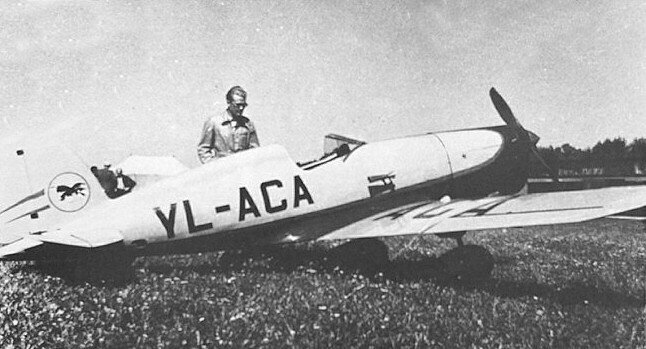From: “Enemy at the Gates: Panic Fighters of the Second World War”
Just eight months after having gained independence, the Latvian Air Force (LAR) was founded on 7 June 7 1919, using aircraft Nieuport Ni.24 bis and Sopwith Strutter. In 1920 the Baltic State reached some political stability by signing the Soviet-Latvian peace treaty.
From 1921 the LAR was reorganized with the acquisition of seven Ansaldo A.1 fighters and four Ansaldo SVA 10 light bombers. They acquired eight Martinsyde ADC-1 fighters in 1926 and four Fiat C.R.1 fighters a year later. Once mass production of Soviet armament started, with the First Five Years Plan of 1928-1932, Latvia purchased eighteen Letov S.16L bombers in 1928, five Bristol Bulldog Mk.II fighters 1929 and seven more in 1930 to counter the threat posed by the new Polikarpov I-3.
Upon learning the performance of the Polikarpov I-16 Type 6 (440 kph) in Spain, Latvia acquired thirteen Gloster Gladiator Mk.I (407 kph) fighters in 1937 and thirteen more in 1938, after the Polikarpov I-16 Type 10 (448 kph) entered into service. That same year they also acquired three Hawker Hind bombers. The Polikarpov I-16 Type 24 (470 kph) appeared in 1939 and Latvia tried to acquire thirty Hawker Hurricane Mk.I and twelve Westland Lysander, but the British cancelled the operation after the German invasion of Poland.
Between 1937 and 1940, the local industry
Valsts Elektro-Fabrika (VEF) produced several all-wood monoplane trainers, with fixed landing gear, that proved to have exceptional flight performances and a great potential, susceptible of being used as ‘emergency fighters’. The VEF I-12 light trainer, built in a number of 12 units, reached 230 kph powered by a Cirrus engine of 90 hp only. In 1938 four aircraft were converted to single-seat fighters, armed with a light machine gun, to be used by the Latvian National Guard.
The VEF I-15, built in 1939, was a single seat training aircraft with two machine guns that could fly at 330 kph with a 210 hp Gipsy Six engine. The VEF I-16, that performed its first flight in 1940, with a maximum speed of 460 kph, a 520 hp Walter
Sagitta ISR engine and four machine guns, was roughly the equal of Polikarpov I-16 Type 24. Construction began on a series of twelve aircraft that was interrupted by the Soviet occupation on 17 June.
After the purchase of Hurricane fighters was cancelled, the Latvian government ordered the design and construction of the air superiority fighter VEF-19 capable of competing with the MiG-3 and the Bf 109E.
The complexity of the hydraulic equipment for the retractable landing gear was above the VEF capabilities and it did not seem possible to obtain engines with more than 500 hp.
These difficulties did not stop the resourceful designer Karlis Irbitis who proposed building a composite engine connecting three D.H. Gipsy Six to each other to make an inverted 'Y', 6 bank, 36-cylinder, 36 litres, air-cooled power plant, driving a three-bladed variable pitch airscrew. The monster, denominated MI-02, could possibly develop up to 1,800 hp at take-off and 1,470 hp at 3,670 m.
The VEF-19 would be built of wood/plywood and armed with four machine guns. It would have had 11 m wingspan, 9.2 m length and 650 kph maximum speed. The plan was to use the American engine Allison V-1710 for the preliminary calculations and for the flight of the first prototype. It was also considered to obtain some Rolls-Royce
Merlin and Hispano-Suiza H.S.12 engines.
In the autumn of 1939 the Cukurs C-6 record airplane was converted into the C-6bis dive bomber with the installation of a 280 hp Hispano-Suiza 6 Mb engine, two machine guns and underwing racks for 150 kg of bombs.
After being tested by the LAR, reaching a speed of 440 kph (clean), the manufacture of 12 units was ordered only 10 days before the Soviet occupation.
The LAR strength on 17 June 1940 was: ten Letov S.16L, six Bristol Bulldog Mk.II, twenty-five Gloster Gladiator Mk.I, three Hawker Hind, four VEF I-12, two VEF I-15, one VEF I-16, one Cukurs C-6bis, twenty R.W.D. 8 and six VEF I-16 in construction.
Bibliography
Books
Humberstone, R.,
Latvian Air Force 1918-1940, Blue Rider Publishing, 2000.
Mason, F.,
The Gloster Gladiator, MacDonald 1964.
Irbitis, K.,
Of Struggle and Flight, The History of Latvian Aviation, Canada Wings, 1988.
Publications
Thomas, A., “Iron Cross Gladiators”,
Håkans Aviation Page.
Passingham, M., “La construction aéronautique de Lettonie”,
Le Fanatique de l’Aviation nº 283, Juin 1993.
Irbitis, K., “Latvia 1940”,
SAFO, vol.14 nº3.
Branke, P., “Latvian Bulldogs”,
SAFO vol.14 nº3.
Davis, C., “Latvia’s Little Hawk”,
Air Enthusiast Forty/Eight.
























